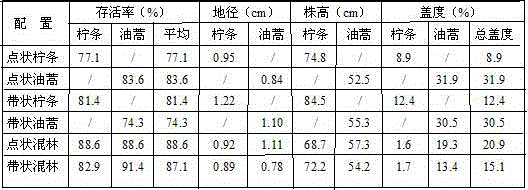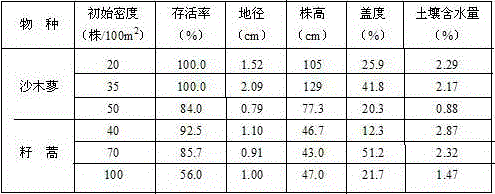A method for planting sand-fixing plants in arid sandy areas
A technology for sand-fixing plants and arid sandy areas, applied in the field of sand-fixing plants in arid sandy areas, can solve the problems affecting the ecological effect of artificial sand-fixing vegetation, the sustainability of ecological restoration, the decline of groundwater level, and the decrease of soil moisture, so as to avoid the damage caused by wind and sand flow , maintain water balance, increase the effect of roughness
- Summary
- Abstract
- Description
- Claims
- Application Information
AI Technical Summary
Problems solved by technology
Method used
Image
Examples
example 1
[0026] 1) Fixed sand surface: In March 2010, a mobile sand dune (area 2.5 hm 2 ), first use 1m×1m grass grid to fix the sand surface;
[0027] 2) Selection of plant species: Select 8 kinds of psammophyte seedlings, including shrub flower stick, Polygonum syringae, Caragana, Azalea, Haloxylon, semi-shrub Artemisia oleifera, and Artemisia oleifera. Seedlings of shrubs and semi-shrubs with a height of 20cm, a diameter of 0.5cm, and a relatively complete root system, the top branches and leaves were removed before the shrubs were planted; the planting time was April 2010, and additional planting was carried out in August 2010 and April 2011 ;
[0028] 3) Planting density: the present invention divides the planting density of psammophyte seedlings into low density: 20 shrubs / 100m 2 And half shrub 40 plants / 100m 2 , medium density: 35 shrubs / 100m 2 And half shrub 70 plants / 100m 2 And high density: 50 shrubs / 100m 2 And half shrubs 100 plants / 100m 2 Three types, the planting de...
PUM
 Login to View More
Login to View More Abstract
Description
Claims
Application Information
 Login to View More
Login to View More - R&D
- Intellectual Property
- Life Sciences
- Materials
- Tech Scout
- Unparalleled Data Quality
- Higher Quality Content
- 60% Fewer Hallucinations
Browse by: Latest US Patents, China's latest patents, Technical Efficacy Thesaurus, Application Domain, Technology Topic, Popular Technical Reports.
© 2025 PatSnap. All rights reserved.Legal|Privacy policy|Modern Slavery Act Transparency Statement|Sitemap|About US| Contact US: help@patsnap.com


